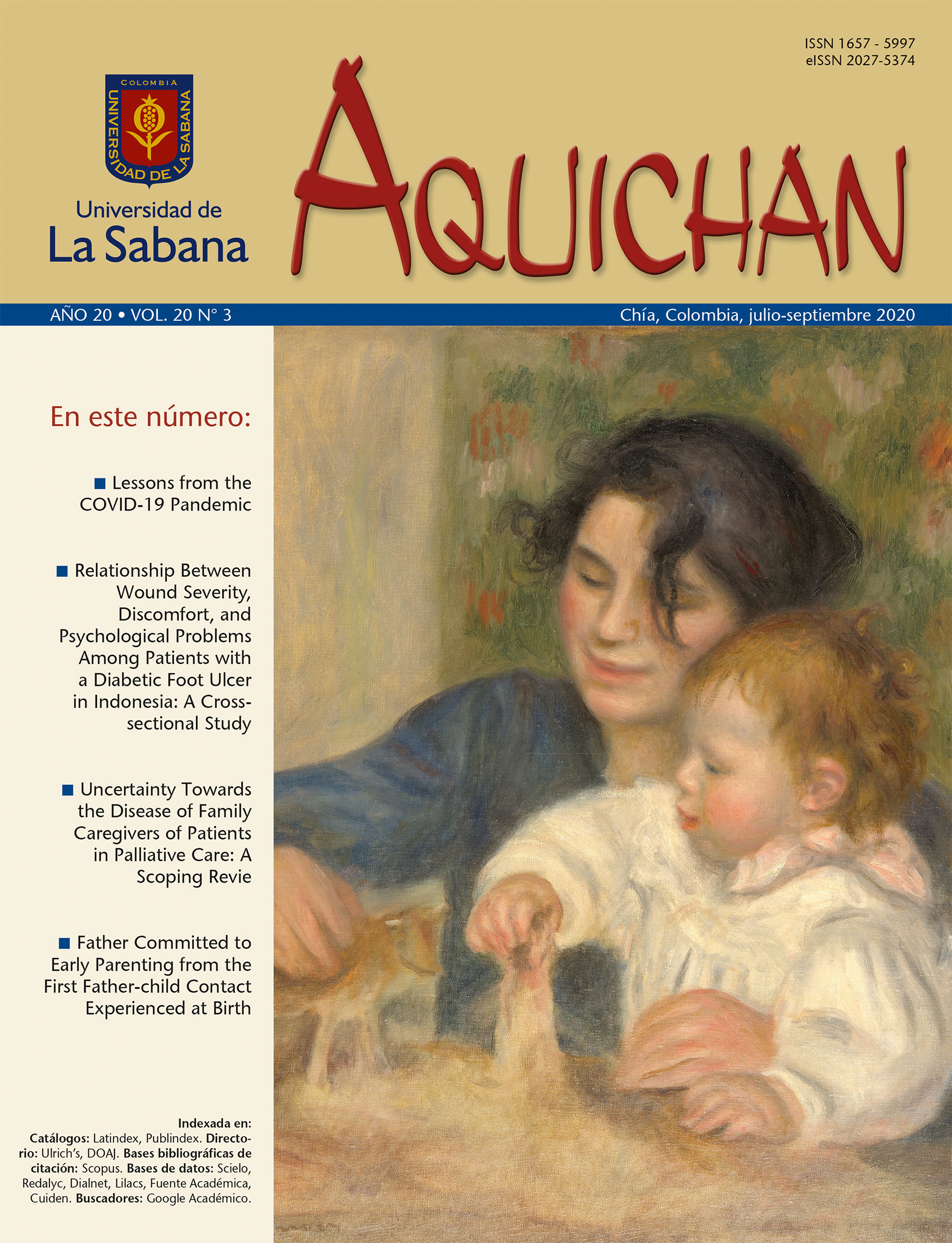Father Committed to Early Parenting from the First Father-child Contact Experienced at Birth
DOI:
https://doi.org/10.5294/aqui.2020.20.3.7Palabras clave:
Crianza del niño, educación prenatal, relación padre-hijo, investigación cualitativa, nacimientoResumen
Padre comprometido con la crianza temprana desde el primer contacto padre-hijo/a vivido en el nacimiento
Pai comprometido em criar seu filho/a desde o primeiro contato pai-filho/a vivenciado com o parto
Objetivo: conocer cómo se muestra el fenómeno de la crianza paterna activa a partir de la experiencia de contacto padre-hijo/a, vivida durante el nacimiento.
Método: análisis de información secundaria de un estudio cualitativo de naturaleza fenomenológica. Transcripciones de entrevistas y grupos focales de todos los padres que participaron de un protocolo de contacto padre-hijo/a para una tesis doctoral.
Resultados: el estudio reveló la estructura global del fenómeno, cuyo eje central corresponde a “padre que transita hacia la conexión integral con su hijo/a y se compromete con la crianza”, y sus tres categorías comprensivas: expectativas de ser padre y actor en la crianza; la vivencia de ser padre en el momento del nacimiento; el día a día de la crianza.
Conclusión: la preparación antenatal y el contacto piel con piel durante el nacimiento movilizan al padre hacia el compromiso e involucramiento con la crianza de su hijo/a desde el comienzo.
To reference this article / Para citar este artículo / Para citar este artigo
García-Portuguez VA, Muñoz-Serrano M, Uribe-Torres C. Father committed to early parenting from the first father-child contact experienced at birth. Aquichan. 2020;20(3):e2037. DOI: https://doi.org/10.5294/aqui.2020.20.3.7
Recibido: 03/04/2020
Aceptado: 10/06/2020
Publicado: 07/09/2020
Descargas
Citas
Moore E, Bergman N, Anderson G, Medley N. Early skin-to-skin contact for mothers and their healthy newborn infants (review). Summary of findings for the main comparison. Cochrane Database Syst Rev [Internet]. 2016;5(11). Disponible en: https://www.ncbi.nlm.nih.gov/pubmed/27885658
Dois CA, Lucchini RC, Villarroel DL, Uribe TC. Efecto del contacto piel con piel sobre la presencia de síntomas depresivos postparto en mujeres de bajo riesgo obstétrico. Rev Chil Pediatr [Internet]. 2013;84(3):285-92. Disponible en: https://scielo.conicyt.cl/pdf/rcp/v84n3/art06.pdf
Smith ER, Bergelson I, Constantian S, Valsangkar B, Chan GJ. Barriers and enablers of health system adoption of kangaroo mother care: A systematic review of caregiver perspectives. BMC Pediatr [Internet]. 2017;17(1):1-17. DOI: http://doi.org/10.1186/s12887-016-0769-5
Velandia M, Uvnäs-Moberg K, Nissen E. Sex differences in newborn interaction with mother or father during skin-to-skin contact after Caesarean section. Acta Paediatr Int J Paediatr [Internet]. 2012;101(4):360-7. DOI: https://doi.org/10.1111/j.1651-2227.2011.02523.x
Blomqvist YT, Rubertsson C, Kylberg E, Jöreskog K, Nyqvist KH. Kangaroo mother care helps fathers of preterm infants gain confidence in the paternal role. J Adv Nurs [Internet]. 2012;68(9):1988-96. DOI: https://doi.org/10.1111/j.1365-2648.2011.05886.x
Velandia M, Matthisen AS, Uvnäs-Moberg K, Nissen E. Onset of vocal interaction between parents and newborns in skin-to-skin contact immediately after elective cesarean section. Birth [Internet]. 2010;37(3):192-201. DOI: https://doi.org/10.1111/j.1523-536X.2010.00406.x
Anderzén-Carlsson A, Lamy ZC, Tingvall M, Eriksson M. Parental experiences of providing skin-to-skin care to their newborn infant. Part 2: A qualitative meta-synthesis. Int J Qual Stud Health Well-being [Internet]. 2014;9. DOI: https://doi.org/10.3402/qhw.v9.24907
Carpenter D. Phenomenology as method. In: Streubert H, Carpenter D, editors. Qualitative Research in Nursing: Advancing the Humanistic Imperative. Philadelphia: Wolters Kluwer Health/ Lippincott Williams & W; 2011. p. 72-96.
Uribe-Torres C, Hoga L. Investigación acción: intervención educativa para la promoción del contacto precoz padre-hijo en el contexto del nacimiento. Sao Paulo: Editorial; 2016.
Streubert H. Designing data generation and management strategies. In: Streubert H, Carpenter D, editores. Qualitative research in nursing: Advancing the humanistic imperative. 5.ª ed. Philadelphia: Wolters Kluwer Health/Lippincott Williams & Wilkins; 2011. p. 33-55.
Palacios B, Sánchez M, Gutiérrez A. Evaluar la calidad en la investigación cualitativa. Guías o checklists. En: Facultad de Ciencias Sociales, Jurídicas y de la Comunicación (Ed), Actas del II Congreso Nacional sobre Metodología de la Investigación en Comunicación y del Simposio Internacional sobre Política Científica en Comunicación [Internet]. Segovia, España; 2013. p. 581-96. Disponible en: http://www.revistalatinacs.org/068/cuadernos/Segovia_actas.pdf
Emanuel E. ¿Qué hace que la investigación clínica sea ética? Siete requisitos éticos. En: Lolas E, Quezada A, editores. Pautas éticas de investigación en sujetos humanos. Ciudad: Nuevas Perspectivas; 2003.
Muñoz-Serrano M, Uribe-Torres C, Hoga L. Fathers prepared for and committed to their role as companions during the birth process. Aquichan [Internet]. 2018;18(4):415-25. DOI: https://doi.org/10.5294/aqui.2018.18.4.4
Entsieh AA, Hallström IK. First-time parents’ prenatal needs for early parenthood preparation: A systematic review and meta-synthesis of qualitative literature. Midwifery [Internet]. 2016;39:1-11. DOI: http://dx.doi.org/10.1016/j.midw.2016.04.006
Erlandsson K, Häggström-Nordin E. Prenatal parental education from the perspective of fathers with experience as primary caregiver immediately following birth: A phenomenographic study. J Perinat Educ [Internet]. 2010;19(1):19-28. DOI: https://doi.org/10.1624/105812410X481537
Sponsler W, Weatherspoon C, Weatherspoon D, Campbell D. Fear of Fatherhood. Int J Childbirth Educ [Internet]. 2015;30(1):33-37 5p. Disponible en: https://scholarworks.waldenu.edu/cgi/viewcontent.cgi?article=1061&context=sn_pubs
Nyqvist KH, Rosenblad A, Volgsten H, Funkquist EL, Mattsson E. Early skin-to-skin contact between healthy late preterm infants and their parents: An observational cohort study. PeerJ [Internet]. 2017;2017(10):1-18. DOI: https://doi.org/10.7717/peerj.3949
Chen EM, Gau ML, Liu CY, Lee TY. Effects of father-neonate skin-to-skin contact on attachment: A randomized controlled trial. Nurs Res Pract [Internet]. 2017;2017:1-8. DOI: http://dx.doi.org/10.1155/2017/8612024
Shorey S, Ang L. Experiences, needs, and perceptions of paternal involvement during the first year after their infants’ birth: A meta-synthesis. PLoS One [Internet]. 2019;14(1):1-22. DOI: http://dx.doi.org/10.1371/journal.pone.0210388
Castillo-Carre A, Espinoza-Venegas M, Luengo-Machuca L. Compromiso paterno y la relación con sus conductas promotoras de salud. Rev Salud Pública [Internet]. 2018;20(5):541-7. DOI: https://doi.org/10.15446/rsap.V20n5.72033
Descargas
Publicado
Cómo citar
Número
Sección
Licencia
Esta revista y sus artículos se publican bajo la licencia CreativeCommons CC BY 4.0 DEED Atribución 4.0 Internacional, usted es libre de: Compartir — copiar y redistribuir el material en cualquier medio o formato para cualquier propósito, incluso comercialmente. Adaptar — remezclar, transformar y construir a partir del material para cualquier propósito, incluso comercialmente. La licencia no puede revocar estas libertades en tanto usted siga los términos de la licencia.









